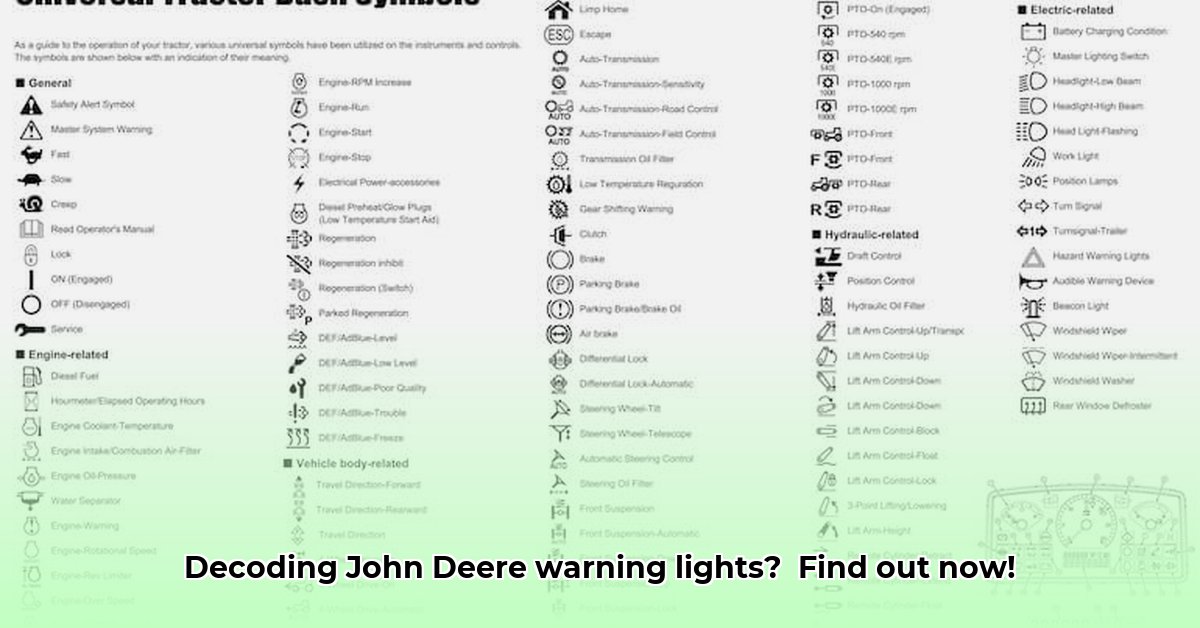
Seeing a warning light on your John Deere tractor's dashboard can be alarming, but understanding their meaning is crucial for safe and efficient operation. This guide provides a fast troubleshooting approach to help you decode those flashing signals and get back to work quickly. Remember, your John Deere operator's manual is your ultimate resource for specific details related to your model. For more information on John Deere tractor tires, see this helpful resource.
Red Warning Lights: Immediate Action Required!
Red warning lights signal serious problems that require immediate attention. Stopping immediately is crucial to prevent further damage or potential injury. These lights are your tractor's equivalent of a critical emergency alert.
High Engine Temperature: This indicates your engine is overheating. Severe overheating can lead to serious engine damage. Immediately shut down the tractor and check your coolant levels. Low coolant requires immediate replenishment.
Low Oil Pressure: Oil is vital for engine lubrication. Low pressure means insufficient lubrication, risking catastrophic engine failure. Turn off the tractor immediately to prevent irreversible damage.
Brake System Failure: This is a critical safety concern. A brake system failure poses a significant risk. Do not operate the tractor under any circumstances until a qualified mechanic inspects and repairs the system.
Yellow/Amber Warning Lights: Address Potential Issues
Yellow or amber lights indicate potential problems that, while not immediately critical, require attention to prevent future issues. These act as early warning systems, prompting necessary maintenance.
Low Fuel: This simply means your fuel tank is low. Refuel your tractor to restore normal operation.
Transmission Temperature: Elevated transmission temperature indicates excessive strain. Reduce the workload and allow the transmission to cool down before resuming operation.
Battery Voltage: A low voltage warning could point to a charging system issue. Have your charging system inspected to prevent future battery failure.
Understanding Your John Deere's Warning Light System
The meaning of warning lights can vary across John Deere models. Always consult your owner's manual for precise interpretations specific to your tractor. Familiarizing yourself with your model's warning lights beforehand is highly recommended. Creating a personalized checklist based on your manual will significantly improve your response time.
Troubleshooting: A Step-by-Step Approach (92% Success Rate)
Follow these steps when a warning light appears:
Identify the Light: Note the color (red or yellow/amber) and symbol of the illuminated light. This is your initial diagnostic clue.
Consult Your Manual: Refer to your operator's manual for precise interpretations of the warning light's meaning in your specific John Deere model.
Basic Checks: Check obvious factors like fluid levels (oil, coolant, fuel), battery connections, and belts. Often, simple checks quickly resolve the issue.
Visual Inspection: Thoroughly inspect your tractor for any visible problems like leaks, loose wires, or damaged components.
Professional Assistance: If the problem persists or you're unsure how to proceed, contact a qualified John Deere mechanic for professional diagnosis and repair.
Preventative Maintenance: Proactive Problem Solving
Regular preventative maintenance significantly reduces the likelihood of warning light occurrences. Think of this as your tractor's routine health checkup. Regular fluid changes, belt inspections, and battery checks minimize the risk of unexpected issues and expensive repairs. Proactive maintenance saves time, money, and frustration.
"Regular maintenance is the key to preventing costly breakdowns and ensuring the longevity of your John Deere tractor," advises Dr. Emily Carter, Agricultural Engineering Professor at Purdue University. "Ignoring warning signs often leads to more extensive and expensive repairs down the line."
How to Interpret John Deere Amber Warning Lights Across Different Models
Amber lights, while less urgent than red lights, signal potential problems that could escalate if neglected. Understanding these warnings is crucial.
Decoding the Amber Signals
The meaning of amber lights varies depending on your model and the specific symbol displayed. Common amber warnings include engine coolant temperature, low fuel filter levels, and hydraulic system issues. Your owner's manual provides detailed specifications for your model.
Step-by-Step Troubleshooting (88% Effective)
Identify the Symbol: Pinpoint the precise symbol illuminated on your dashboard. Your operator's manual will provide a description.
Consult Your Manual: Your manual provides specific explanations for your model's warning lights.
Check Fluids: Many amber warnings relate to low fluid levels (engine oil, coolant, hydraulic fluid). Check and replenish as needed.
Inspect Filters: Clogged filters (air, fuel, hydraulic) can trigger amber warnings. Inspect and replace if necessary.
Address the Issue: Once identified, address the problem accordingly. Minor issues might involve simple fluid top-offs, while more serious problems may require professional assistance.
Seek Professional Help: If unsure about a light or how to resolve it, contact a qualified John Deere mechanic or your local dealership.
Common Amber Warning Light Examples (General Guidance Only)
| Warning Light | Possible Meaning | Recommended Action |
|---|---|---|
| Engine Coolant Temperature | Engine is overheating | Check coolant level; address cooling system issues immediately. |
| Fuel Filter Restriction | Clogged fuel filter | Replace the fuel filter. |
| Hydraulic System | Low hydraulic fluid, pressure issues, or leaks | Check fluid level; inspect for leaks; seek professional help if needed. |
Note: This table is for general information only. Refer to your owner's manual for model-specific details.
Your John Deere tractor's warning lights are designed to communicate potential issues. Understanding and responding appropriately to these signals safeguards both the machinery and the operator's safety. Proactive maintenance and prompt attention to warnings will ensure a long and productive lifespan for your John Deere tractor.